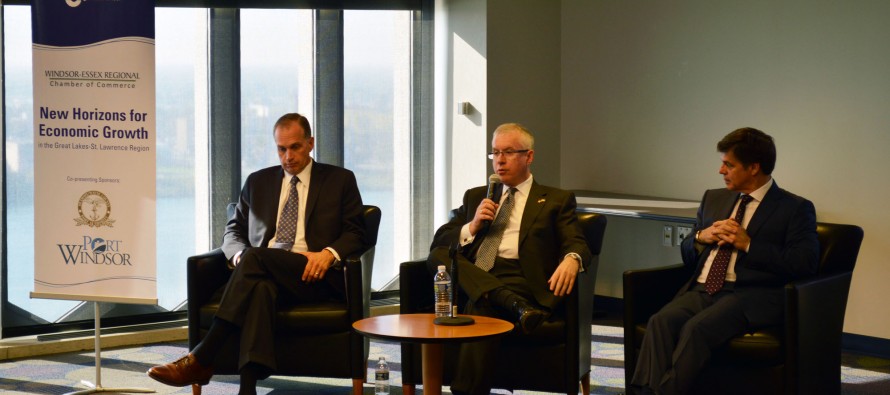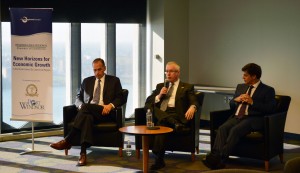International experts discuss advantages of ‘marine highway’


WINDSOR, ON.: President and CEO of The Interlake Steamship Company Mark Barker (left) and Terrence Bowles, President and CEO of the St. Lawrence Seaway Management Company (right) listen while Canada’s Consulate General in Detroit Roy Norton (center) speaks during the question/answer period of an event held at the office of the Detroit Regional Chamber of Commerce, Oct. 11. (Photo by/Richard Riosa)
By Richard Riosa
Top executives for the Great Lakes – St. Lawrence Seaway are calling for an increase in industrial shipping in the region.
Executives from both sides of the border attended a breakfast event in Detroit Oct. 11, hosted by the Detroit Regional Chamber of Commerce and the Windsor-Essex Regional Chamber of Commerce. The Detroit/Wayne County Port Authority and the Windsor Port Authority sponsored the event and were also in attendance. The event featured speeches from Canadian and American executives outlining the economic and environmental benefits of marine shipping.
According to a brochure available at the event, published by Marine Delivers, marine shipping produces $33.5 billion in economic contribution annually and saves cargo shippers $3.6 billion in transportation costs each year. Marine Delivers is jointly managed by the American Great Lakes Port Association and the Chamber of Marine Commerce.
Canada’s Consulate General in Detroit Roy Norton introduced the two main speakers and moderated the question/answer period. He said within the Great Lakes region, the U.S. and Canada essentially share one integrated economy. Because of this, Norton said both countries must work together to improve marine logistics.
The region contains more than 100 commercial ports and more than 42 major industrial shipping ports. The seaway plays an important role in the transportation of iron ore, coal, grain and liquid bulk oil.
Terrence Bowles, president and CEO of the St. Lawrence Seaway Management Corporation, which oversees the operation of the Canadian portion of the seaway, was one of the main speakers at the event.
Bowles said the management corporation is currently in the process of updating and automating their systems. This new system, according to Bowles, is currently operational in one of the seaway’s 15 locks and will be fully implemented within the next three years.
“I think it’s going to enable us to offer more competitive tolls, which in the end makes the various carriers and shippers more competitive,” said Bowles.
The lower cost of tolls due to the automated locks, according to Bowles, will help the seaway remain a competitive alternative to trucking.
President and CEO of the Interlake Steamship Company Mark Barker was the other main speaker at the event. Interlake Steamship owns and operates Great Lakes freighters.
Barker also said marine shipping offers a low cost alternative to trucks and cargo trains.
“As congestion of our roads increases, as the focus on reduction of emissions continues, we’re (well) positioned because we’re low impact,” said Barker. “We’re already, on a per-ton mile, the lowest form of emissions. One of my biggest ships can carry 600 to 700 rail cars in one trip versus a 100-car train.”
Interlake Steamship, according to Barker, has fully modernized and automated their entire fleet, which has decreased freighter emissions by almost 40 per cent. He also said Interlake Steamship is also currently researching natural gas as a long-term fuel source in an attempt to further lower emissions.
“We’re exploring that (natural gas),” said Barker. “It’s a new technology for the maritime, but it’s one that’s viable for certain parts of the industry and we think the Great Lakes is posed to be able to utilize that fuel and I think that would be a great thing for the region, not only because the fuel comes from the region, but from an emission profile that we will have going forward.”
Barker said his company’s focus on lowering emissions and cost of shipping will help to bring in more business for the region.
According to Bowles, more than 200,000 jobs depend on the St. Lawrence Seaway on both sides of the border. He said the management corporation markets to roughly 59 countries in an attempt to attract more business, which would help create more jobs in the Great Lakes region.
“We’d like to see more business coming onto the marine highway,” said Bowles.


